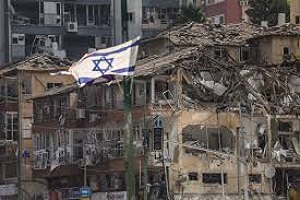On June 19, 2025, Iran escalated the already volatile conflict with Israel by launching a ballistic missile armed with cluster bomb submunitions, marking a dangerous and controversial new chapter in the war.
The Israel Defense Forces (IDF) confirmed that the missile’s warhead exploded mid-air.
Dispersing approximately 20 smaller bomblets over an 8-kilometer radius in central Israel.
This unprecedented use of cluster munitions by Iran has sparked outrage, fear, and condemnation worldwide.
The cluster bomb warhead released dozens of submunitions designed to explode on impact.
Spreading destruction over a wide area rather than a single point.
Cluster bomb warhead released:
One of these bomblets, containing roughly 2.5 kilograms of explosives.
Struck a residential home in the town of Azor, causing damage comparable to a small rocket attack.
Fortunately, no casualties were reported from that particular strike.
But the danger posed by unexploded ordnance remains severe.
Israeli authorities have reported the disposal of 20 unexploded bombs.
And warned civilians to avoid any missile debris and immediately report suspicious objects to the Home Front Command.
The use of cluster bombs widely condemned as indiscriminate and inhumane weapons has intensified fears of civilian casualties and long-term hazards.
Cluster munitions are notorious for leaving dangerous unexploded bomblets that can maim or kill civilians years after a conflict ends.
International bans:
Despite international bans under the 2008 Convention on Cluster Munitions.
Iran and Israel remain among the countries that have not signed the treaty.
Allowing such weapons to be deployed with little legal restraint.
The Israeli embassy in Washington condemned the attack, describing it as a blatant violation of humanitarian norms.
The IDF spokesperson accused Iran’s regime of deliberately targeting civilians to maximize harm and terror.
This attack is part of a relentless barrage by Iran, which has launched over 450 missiles.
And approximately 1,000 drones at Israel since the conflict began last week.
Iran’s strikes are a direct retaliation to Israel’s offensive targeting Iranian military leaders.
Ballistic Missile Infrastructure
Nuclear scientists, uranium enrichment sites, and ballistic missile infrastructure.
Israel insists its campaign aims to prevent Iran from achieving its stated goal of destroying the Jewish state.
Other missiles fired on June 19 carried conventional warheads, hitting critical infrastructure and civilian areas.
Soroka Medical Center in Beersheba suffered a direct hit, causing extensive damage and a suspected chemical leak.
Seventy-one people were lightly injured there, with others treated for acute anxiety.
Residential buildings in Ramat Gan and Holon were also struck.
Resulting in numerous injuries and significant property damage.
Since the conflict’s outbreak, 24 Israelis have been killed and hundreds wounded, many in missile strikes on apartment buildings.
The attack on Soroka Hospital, a vital medical facility, has drawn sharp condemnation.
Israeli Foreign Minister Gideon Sa’ar accused Iran of committing war crimes, saying, “The Iranian regime deliberately targets civilians has no red lines.”
Opposition leader Avigdor Lieberman warned, “Imagine what Iran would do with nuclear weapons,” urging Israel to intensify its fight.
Defense Minister Israel Katz called Iran’s Supreme Leader Ali Khamenei “the modern Hitler” and declared that eliminating him aligns with Israel’s war objectives.
International response has been swift but divided.
European diplomats convened in Geneva, urging restraint and diplomacy to prevent further escalation.
However, with missile exchanges intensifying and no clear diplomatic breakthrough, fears of a wider regional war grow.
Human rights groups have condemned the use of cluster bombs, warning of their long-term dangers to civilians.
Iran has not publicly commented on the cluster bomb allegations.
Israeli officials have vowed to intensify their campaign, signaling a protracted and brutal conflict ahead.
The use of cluster munitions by Iran has shattered any illusions about the conflict’s limits.
It exposes a brutal reality where civilian populations bear the brunt of escalating hostilities.
The unexploded bomblets scattered across central Israel serve as a deadly reminder of the war’s indiscriminate nature.
Dangerous escalation:
For Wahalaupdate readers, this development signals a dangerous escalation with profound humanitarian implications.
The deployment of cluster bombs banned by most of the world demonstrates.
Iran’s willingness to escalate indiscriminately, risking countless civilian lives.
The international community will face harsh judgment if it fails to respond as the conflict intensifies.
As Israel vows harsh retaliation and Iran continues missile and drone strikes, the question remains: how many more civilians must suffer before the world intervenes to halt the bloodshed?
The June 19 cluster bomb attack has made one thing clear this war is far from over, and its consequences will be devastating.



2 Comments
Pingback: U.S: Massive strikes on Iran’s Nuclear sites - wahalaupdate
rflwvq